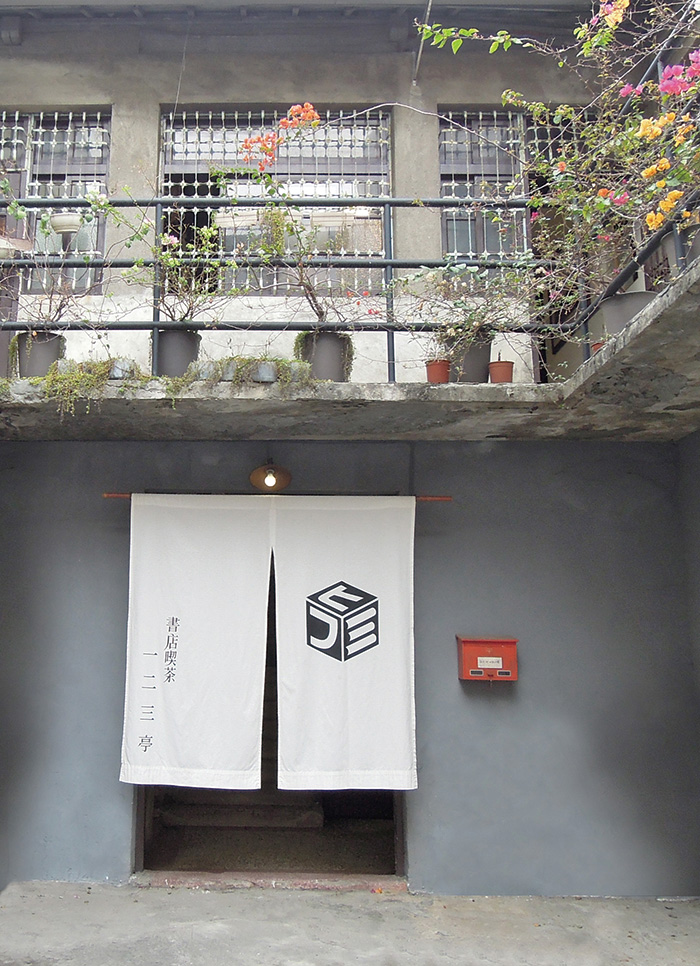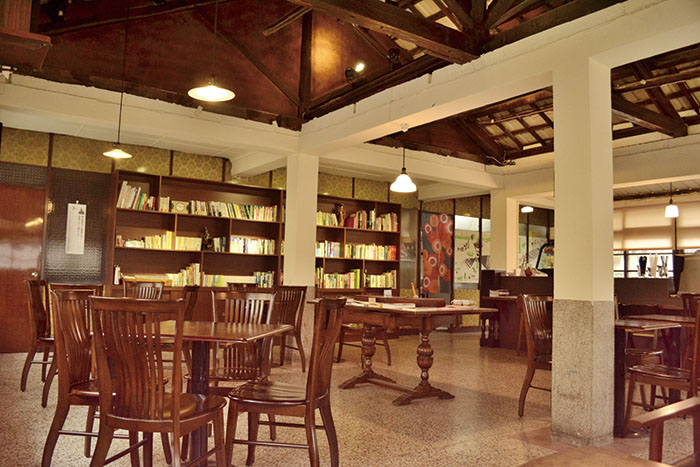Yao Ming-wei Brings New Life to an Old Building/找到老房子的靈魂,城市推手姚銘偉的咖啡店願景
Yao Ming-wei Brings New Life to an Old Building
◎English translation: Peng Hsin-yi
◎Photos by Chang Mian-mian, Tomoaki Kuramoto
 Hamasen, a district, is situated right next to the Port of Kaohsiung. It was previously a landfill. In Taisho 9 (1920), after eight years of arduous work, it was transformed. Back in those days, Japanese businessmen would leave the train station and head over to Shinhamachou Yichichomei where "Hifumitei Ryotei" was located. Hifumitei Ryotei managed to weather the air raids in WWII and government campaigns to demolish old neighborhoods. In 2014, Hifumitei Ryotei still continues to operate on the second floor of what is now over a century-old building, near the Mass Rapid Transit station on Guyuan Street.
Hamasen, a district, is situated right next to the Port of Kaohsiung. It was previously a landfill. In Taisho 9 (1920), after eight years of arduous work, it was transformed. Back in those days, Japanese businessmen would leave the train station and head over to Shinhamachou Yichichomei where "Hifumitei Ryotei" was located. Hifumitei Ryotei managed to weather the air raids in WWII and government campaigns to demolish old neighborhoods. In 2014, Hifumitei Ryotei still continues to operate on the second floor of what is now over a century-old building, near the Mass Rapid Transit station on Guyuan Street.
In 2012, Mr. Yao Ming-wei, former owner of Hifumitei Ryotei, found out this building was up for demolition. Teaming up with the Takao Renaissance Association, he rallied the local residents to protest. It was then that Mr. Yao found a new purpose for the building and opened a coffee house. In September 2015, it was finally confirmed the building was not going to be turned into a parking lot. He then sold the business to his old schoolmate and owner of Apartment Cafe.
Before he ran a coffee shop, Mr. Yao was a teacher of an afterschool program. Although, from the outside, it appears that Mr. Yao made a really drastic jump in becoming a coffee house owner; however, he did in fact graduate from the National Kaohsiung University of Hospitality and Tourism and went on to earn an MBA in Switzerland. Combined with his passion for literature and history, he brings a unique aesthetic. He was indeed the perfect person to breathe new life into Hifumitei Ryotei.
The two most important decisions he made when he first opened the coffee shop were to restore the building to its original architecture and remove the ceiling to expose the original wooden beams. He believed these elements would be essential in bringing out the building's true character. "I also put my collection of old photos on display, which I feel depicts the local history," Mr. Yao explains. In English, the name can be translated as, "Bookstore Cafe". "Hamasen was a college town and therefore it should have a proper bookstore". Mr. Yao then installed bookshelves along the walls and filled them with books from his own collection and books donated from local publishing houses. This he feels was the very essence of what he had envisioned for his coffee shop.
Periodically, he holds seminars. A variety of speakers have been through. This he feels reflects the coffee shop's roots, where historically young people would gather to exchange ideologies or even discuss revolution. "I love it; everyone can come here to share ideas." Mr. Yao certainly created a truly unique coffee shop whilst he was its owner.
Since Hamasen is a tourist destination, busy times can fluctuate from day to day. Guyuan Street is a quiet street with very little traffic. Mr. Yao had to use a variety of social media sites in order to let people know about his coffee shop. One week before the grand opening, Mr. Yao held a "Philosophy Friday" seminar that he advertised on the coffee shop's Facebook. The event drew a full house and successfully introduced customers to his charming new space. After that they just kept coming back.
"In the past, the secret to a coffee shop's success was, 'location, location, location,' but now it is more important to be unique". These days, it is considered rather chic to remodel old houses. Mr. Yao believes it is important to maintain the building's essence and unveil its unique history. By doing this, each old house will have its own unique story to share with visitors.
Other coffee shops also have unique atmosphere in Kaohsiung including Hsiaoti Cafe, Apartment Cafe and Cafe Strada, which provide a homey and relaxed environment. Mr. Yao advises that in order to run a coffee shop, the owner must first have a clear, unique vision, which contributes to positive change. He feels his business has cultivated a distinct culture in Kaohsiung while still attracting tourists. He believes his coffee shop is very refined and reflects the very essence of this vigorous city.
找到老房子的靈魂,城市推手姚銘偉的咖啡店願景
◎文/張棉棉
◎攝影/張棉棉、倉本知明
老屋子的前世今生
1920年,大正九年。位於高雄港旁、填海完成八年的哈瑪星正要進入夜晚。剛出站的日本商人提著皮箱,轉進新濱町一丁目的「一二三亭」。來自九州的藝妓推開拉門,透著燈光觥籌交錯。燈光照不到的天花板頂上,上棟儀式時神官加持過的幣串,靜靜在黑暗中守護、祈求屋子與屋內的人一切安好。
2012年,哈瑪星繁華不再,但幣串仍然堅守著。躲過了美軍轟炸、市政府的拆除行動,九十四年的老幣串,在2014年被拂去灰塵、換上新衣、重返老崗位,繼續守護近百年的老屋重新掛上的招牌,及每一個掀開布簾,走上二樓的客人。出了捷運站轉進鼓元街,房子在九重葛的環繞下等在那裡。而原本「一二三亭」這個前世的名字旁,加上「書店喫茶」四個字,這便是百年老屋的今生了。
賦予這棟老屋新生命的,是「書店喫茶。一二三亭」的前任老闆─姚銘偉先生。2012年得知哈瑪星的老屋即將被拆除,便與「打狗文史再興會社」的夥伴集結居民一同抗爭,讓這裡免於被改建成停車場的命運。而他也決定承接這間老屋,實現一直以來的夢想─開咖啡廳。直到去年九月,在確認「一二三亭」能繼續保存後,將經營權轉給昔日同窗─「公寓咖啡」的老闆,轉身追求下一個夢想。
屋子的個性、咖啡館的靈魂

咖啡廳之前,他的正職是補習班老師。乍看是跨界轉職,但高雄餐旅學院畢業,又到瑞士攻讀MBA的他,兼具烹飪技術與商業頭腦,更重要的,是他自小對文史的熱愛及天生的美感,造就「一二三亭」成為一間與眾不同,有「靈魂」的咖啡廳。開店之初他便決定了兩件事:還原老屋原貌以展現它的個性、以及找到「一二三亭」的靈魂。從日本運來符合大正、昭和時期的家具,拆開天花板、讓九十年的木造屋頂裸露出來─「因為我有收藏老照片的習慣,知道該怎麼展現這間屋子的歷史。」靈魂則是來自「書店喫茶」這個新名字,「哈瑪星是個大學城,為什麼沒有書店?」於是沿著牆面架起了大書櫃,跟出版社合作、也擺出自己的藏書,客人只要在書架前一站,就會讀懂這間咖啡廳的靈魂。他也定期邀請各界好友來舉辦講座,基進側翼、史明、田中實加,時間若倒轉個幾十年,這裡儼然就是有理想的青年們,密謀討論革命的秘密基地。「我很喜歡這種感覺,大家聚集在咖啡廳討論思想。」這是姚銘偉身為店主時期,賦予這間店的靈魂。
給下一個咖啡館老闆的備忘錄
哈瑪星是觀光景點,白天晚上、假日平日的人潮落差大,鼓元街的過路客也少,於是網路社群的經營很重要。開店前一週,姚銘偉在店裡舉辦一場「哲學星期五」講座作為暖場,透過臉書宣傳,預告有這麼一間店、將會有什麼事情在這裡持續發生。文化講座聚集人潮,屋子的特色被看見了,客人願意不辭千里來看看這間老屋。「地點曾經是一個關鍵因素,現在特色更重要。」這幾年,老屋新生變成一種流行,但靠在牆角的老皮箱、打字機,還有桌上千篇一律的鬆餅,常讓人誤以為走進一間連鎖店。姚銘偉建議,與其販賣懷舊,更該探究每間老屋的歷史,傾聽房子的故事,說給來到這裡的人聽。
咖啡地圖、文化藍圖
經營者灌注其中的靈魂,造就一間讓人一去再去的咖啡廳─「小堤咖啡」自然而然的氛圍、「公寓咖啡」家的感覺,還有文青咖啡廳先驅的「步道咖啡館」,串連出姚銘偉的高雄市咖啡地圖。「開咖啡廳的人必須有一個願景,期望這間店能帶給高雄一些改變。」高雄有海港,又是軍事基地,若是有一間船上咖啡廳,每天載著客人出海喝咖啡;又或是一間軍事相關的書店,讓高雄在發展觀光同時兼具文化內涵,「把高雄生猛的個性,用精緻的方式呈現。」訪談結束後,姚先生臨時起意,繞去渡船頭「握咖啡」買豆子回家,「老闆是世界烘豆冠軍,把咖啡做到這樣極致,也是他的靈魂。」
而我看著他撐傘步行在哈瑪星的背影,開始期待他正在籌備中、年底將出刊的雜誌會有何種靈魂。